Apple's 2010 MacBook Air (11 & 13 inch) Thoroughly Reviewed
by Anand Lal Shimpi on October 26, 2010 10:08 PM EST- Posted in
- Mac
- Apple
- MacBook Air
- Laptops
The 11-inch MacBook Air: Faster than the old 13-inch MacBook Air
On paper, the new 13-inch MacBook Air shouldn’t be any faster than the old 2008 MacBook Air - at least in CPU bound tasks. The 2010 model gets a faster GPU but the CPU is literally the same 1.86GHz Core 2 Duo. Memory sizes and speeds haven’t changed either. While the SSD is faster, if you’re running a CPU bound benchmark there shouldn’t be any performance difference. If you assumed the same thing I did, you’d be very wrong.
Take a look at Cinebench 11 comparing the 2008 13-inch MacBook Air to the two 2010 models:
| Cinebench 11 - Multithreaded CPU Benchmark | |||||
| 11-inch MacBook Air (2010) - 1.4GHz Core 2 Duo | 13-inch MacBook Air (2010) - 1.86GHz Core 2 Duo | 13-inch MacBook Air (2008) - 1.86GHz Core 2 Duo | |||
| Cinebench 11 Score (Higher is Better) | 0.81 | 1.1 | 0.70 | ||
Not only is the 2008 13-inch MBA slower than the new 13-inch model, it’s actually slower than the 11-inch model running at 1.4GHz. Something is amiss. Perhaps it’s just this benchmark?
I turned to our Handbrake H.264 encode test to verify my sanity:
| Handbrake 0.94 - H.264 High Profile Transcode | |||||
| 11-inch MacBook Air (2010) - 1.4GHz Core 2 Duo | 13-inch MacBook Air (2010) - 1.86GHz Core 2 Duo | 13-inch MacBook Air (2008) - 1.86GHz Core 2 Duo | |||
| Average Frames per Second (Higher is Better) | 1.14 fps | 1.55 fps | 0.96 fps | ||
Once again, a similar situation. The old MBA is actually slower than the new 11-inch, despite the advantage in CPU speed.
It looks like what we’ve stumbled upon is a combination of Apple aggressively throttling the clock speed of the older MacBook Air CPUs to meet thermal requirements, and the CPUs used in the new MacBook Airs being far better behaved from a voltage/power consumption standpoint.
The 45nm process these Core 2s are built on is as mature as it’s going to get. I’m guessing yield on these parts is as high as can be and as a result, power consumption is probably consistently lower than the original 1.86GHz parts Apple shipped back in 2008. The peak thermal specs themselves haven’t changed, but the actual power characteristics have.
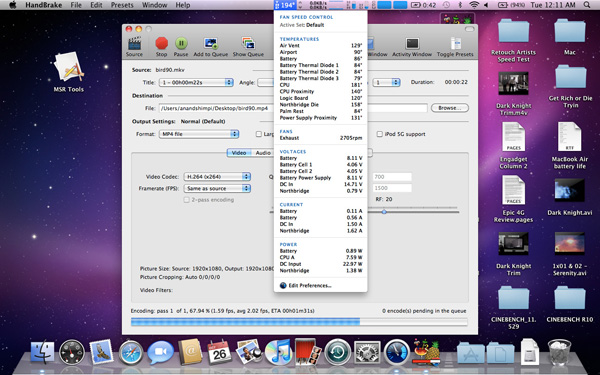
The 2008 MacBook Air under Load
Maximum temperature, at least reported by the MBA’s sensors, isn’t any lower on the new 13-inch than the 2008 I compared it to. Both CPUs hit roughly 84C (183F) under full load. But look at what happens to the chips after a minute at that load:
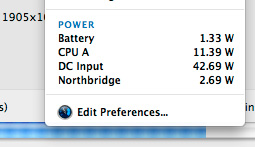 2010 13-inch MacBook Air |
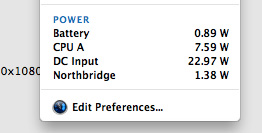 2008 13-inch MacBook Air |
iStat Menus reports the 1.86GHz Core 2 Duo in the 2008 system consuming only 7.59W, while the same CPU in the 2010 machine is drawing 11.45W. The 2008 machine is throttling back to reduce overall temperature while the 2010 system keeps going.
As a result, even the 11-inch MacBook Air will probably end up being as fast, if not faster than the 2nd generation 2008 13-inch MacBook Air. And our performance results confirm that:
| 11-inch MacBook Air (2010) vs. 13-inch MacBook Air (2008) | ||||||||
| Application Launch Test | Adobe Photoshop CS4 | Aperture RAW Import | Cinebench R10 - 1CPU | Cinebench R10 - XCPU | Quicktime H.264 Transcode | |||
| Apple 11-inch MacBook Air (2010) - 1.4GHz Core 2 Duo | 27.8 seconds | 72.4 seconds | 1.29 PPS | 1612 | 2967 | 33.1 fps | ||
| Apple 13-inch MacBook Air (2008) - 1.86GHz Core 2 Duo | 26.4 seconds | 71.3 seconds | 1.20 PPS | 2046 | 2882 | 30.1 fps | ||
You'll notice the less CPU intensive tasks are quicker on the old 13-inch system as the CPU isn't able to get hot enough to trigger Apple's throttling. The single threaded Cinebench test is the best example of this. The 26% performance advantage jibes with the 33% increase in CPU clock speed (it's actually a little low, most likely because the old CPU still isn't running at full speed even in this test). But now look at the heavier tests - the multithreaded Cinebench test and the Quicktime encode. Both of these stress both cores and drive TDP up, which forces Apple to pull clock speed back down. We wondered how Apple was able to cram such a high speed CPU into such a thin chassis as early as it did, now we know.
In practice I found the 2008 13-inch MBA launched applications quicker (short bursts of full clock speed), but after prolonged use or completing CPU intensive tasks it was tough to tell apart from the new 11-inch. What's even more troublesome is that Apple's aggressive clock throttling went relatively undetected until now. This is something I'm going to have to devise tests for and pay more attention to in future reviews. Sneaky, Steve, sneaky.
External Temperatures and Noise
The old MacBook Air chassis had a few dozen slits cut out of the aluminum for ventilation. The new MacBook Air chassis hides the ventilation slits between the base of the unit and the hinge. You can’t see them, but they’re there.
The slits are smaller than they were on the old chassis, which means moving air through them at the same rate sounds louder than before.
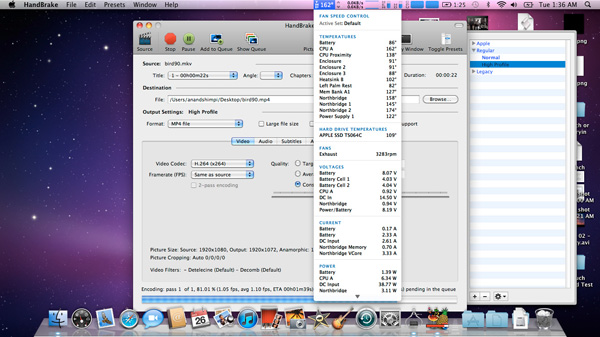
The 11-inch MacBook Air under Load
The CPU in the 11-inch model, even when under heavy loads, likes to stay at or below 72C (162F). At that temperature, the internal fan doesn’t spin above 4000 RPM (usually down below 3400). The 13-inch MacBook Air however is far more likely to generate noise. Running our simple Handbrake test the CPU will peak at over 82C (~180F) and the system’s internal fan will ramp up to over 6K RPM to compensate. Not only does the chassis get hot, but the fan gets audible. It’s still too small of a fan to really be considered loud in the grand scheme of things, but it’s loud enough to be annoying.
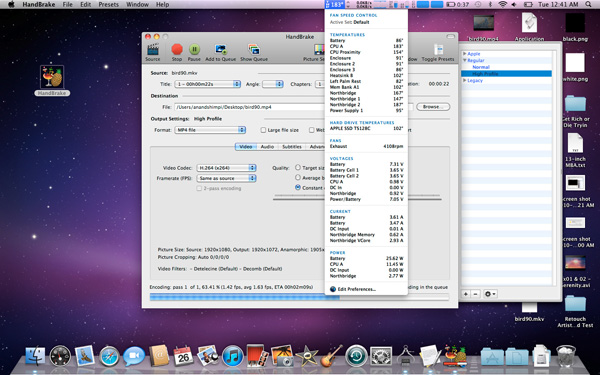
The 13-inch Macbook Air under Load
The surface temperature of the new 13-inch MacBook Air easily gets as high as the 2008 model. I measured a peak of 38.9C (102F) on both the 2008 and 2010 13-inch models. The 11-inch never broke 38C (100F).
Even casual use can ramp up temperatures pretty quickly. Just having a few websites open in the background that use Flash or other CPU intensive elements can slowly cause the MBA’s internal temperatures to rise. And now you’re beginning to see why Apple doesn’t install Flash on these things by default.
The danger zone is the upper left corner of the system, near the hinge. There’s only a single fan that cools both the CPU and GPU in the Air’s very tight enclosure. This is where that fan sits.










185 Comments
View All Comments
JVC8bal - Wednesday, October 27, 2010 - link
Good case. Another example is Porsche, who has the widest profit margins of any car company. A 911 doesn't cost anything near what people will pay for them, and adding a $8,000 turbo doesn't equate to the $40,000 premium they can charge for it.ImSpartacus - Thursday, October 28, 2010 - link
Did you even bother reading the entire comment? I thought it was logical enough.A business is in the business of making money, not selling things. If a business can make more money by selling fewer things, they will do it.
quiksilvr - Wednesday, October 27, 2010 - link
I should have been clear:It will never happen because it makes to much sense to US. I'm not talking about the general unwashed masses that have an orgasm over an Apple Logo.
I'm talking about sensible people that would rather spend half as much for an ASUS Eee PC 1215N, or people that want luxury would get the HP Envy 14 or 17.
tno - Wednesday, December 29, 2010 - link
Wow. Sorry to kick up a dead thread, and I really hope I don't restart it. I just was really surprised by that comment. If you're kidding, maybe you're one of those griefers that says this stuff for kicks, then I guess that's your bag and you carry it, but seems silly to me. If you're serious, then you really have quite the glut of self esteem.My advice. Try it out. Want to keep your nose up? That's fine, don't buy one, just hackintosh a rig you've got. Don't game on it. Work on it. Read all the griefer blogs you want. Write on it. Produce something with it. I'm not an owner, yet, I'm a hackintosher. And having used XP, Win 7, Ubuntu and OS X on my netbook, laptop and desktop, OS X is my favorite platform to get work done, and the only one I would want to use on something with a screen smaller than 17".
If you give it a try and you still think Apple b10ws and you r001, fine. Us unwashed masses will just keep getting things done and loving every minute of it.
robco - Wednesday, October 27, 2010 - link
There's a few technical reasons why some of these things don't exist in the MBA. Apple can't use the iSeries chips in their low-end products because Intel has blocked third-party integrated graphics. The MBA doesn't have space for a discrete GPU. Intel's integrated graphics don't support OpenCL, something Apple intends to make use of going forward. USB 3.0 is a nice idea, but at the moment, requires a separate controller chip, something else there isn't room for. Hopefully either Intel will make decent graphics (I'm not holding my breath) or AMD will come out with a decent mobile CPU with better integrated graphics. I would imagine the microphone got moved because it wouldn't fit into the new, thinner display. Including an adapter isn't something that can be done at the factory - which would they include? Some folks will want VGA, some DVI, others might spring for the Cinema Display and not need it. As for the ExpressCard slot, I do with they remove the optical drive from the MB and MBP and add that, plus an extra USB port or two. I can count on one hand the number of times I've used an optical drive in the past four years.No offense, but I imagine Apple's engineers considered all these things and more. I looked at Windows laptops before getting my 15" MBP and good quality laptops are expensive no matter who makes them. I had a hard time finding anyone who could offer a fully featured notebook in a case less than an inch thin, with a high quality display, excellent battery life and rated EPEAT Gold. Apple just doesn't compete at the low end. By the time you take that $699 Windows laptops and start adding options, the price difference shrinks considerably.
softdrinkviking - Wednesday, October 27, 2010 - link
that's a very "can't do" kind of attitude.i really like apple's designs, but i really don't like the outdated processors they are using.
i refuse to believe that there is NOTHING that apple could do to bring better tech to it's fans.
it's very disappointing. :(
coldpower27 - Wednesday, October 27, 2010 - link
Well Apple wants to support a certain feature set, and they can't do so if they go Intel and their lackluster integrated Graphics. They want nVidia graphics.If they tried to add Intel's Westmere based products with Integrated Graphics it would become a 3 chip solution. They have done this for the 15/17 markets where the chasis can hold everything and the larger battery required.
On the 11/13 where space is premium it's integrated nVidia graphics, once Sandy Bridge rolls around, we may see that change....as Intel graphics is on the CPU itself.
tno - Wednesday, December 29, 2010 - link
This is exactly it. While Dell/Asus/Gateway churn out laptops designed to be able to fit whatever will be required of them from the next CPU/GPU/chipset, Apple chooses a set of function requirements and build their design out of that. The 11/13 size laptops are all about portability, so big batteries and thin designs at the expense of the newest, fastest processor. It's pertinent that when Dell decided to build an MBA competitor (the Adamo) they went with a rather similar specification, and ended up with worse battery life.So, could Apple sell a laptop for $600? Yep. It'd have a plastic chassis, carry whatever the cheapest processor they can squeeze out of Intel, the same crappy Clickpad everyone's slapping on their laptops, have a craptastic LCD, mediocre battery life and run Windows 7. Thanks, but no thanks. I'll go get a Mac.
OrionAntares - Wednesday, October 27, 2010 - link
Something about the MacBook Air and the processors. If they moved away from the Core 2 I'm pretty sure given the size constraints they'd need to stick with the Pentium and/or i3 ULVs. Making the Air thicker would be contrary to the whole point of the Air line. If you want a stronger processor (and more thickness) you'd go up to the regular Macbook line that is already thicker.JVC8bal - Wednesday, October 27, 2010 - link
I concur, this guy is a tard that doesn't know anything about systems engineering or manufacturing or "productizing".